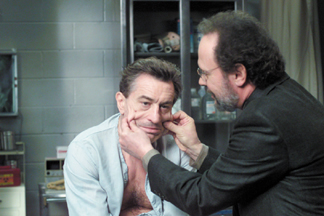Analyze That
Fughedabout Dis Retread
By Patrick Reed

“Smile. At least it’s not a sequel to Showtime.”
Released in March 1999, Analyze This was a textbook "high concept" movie; that is, a movie that could be summarized-and pitched to executives-in one pithy sentence. The process is as follows: take a familiar genre (in this case gangster film) and tweak the formula just enough to make it (sort of) fresh. With Analyze This, the concept was a cinch. Pairing an impulsive and crude Mafia don with a reserved psychiatrist wasn't an original idea by any means (remember the 70s Saturday Night Live sketch with John Belushi as Don Corleone in group therapy: "Vito, you're blocking.") Still, why not stretch the concept into a full-length comedy, especially if Robert De Niro and Billy Crystal can play the leads? Funnily enough, as Analyze This was being made, the godfather-shrink premise was also in bloom over at HBO. Well, you know the rest. The Sopranos premiered in January of '99, and soon became a pop-culture institution. Analyze This made over $100 million on a $30 million budget. "Hey," the powers-that-be in Hollywood must have thought, "this damn idea is so good the public lapped it up twice. Why not give 'em some more?" And so they have.
Analyze This contained one hilarious scene-an immaculate homage to Brando's assassination at the sidewalk fruit stand in The Godfather. Otherwise, the film coasted on the rapport between Mafioso De Niro and head-doctor Crystal. Several of their scenes together had a snappy verbal dexterity, primarily due to Crystal's old-school timing, but De Niro seemed to relish the role of John Gotti stand-in Paul Vitti as well. Analyze This' screenplay, by Kenneth Lonergan, Peter Tolan, and director Harold Ramis, overflowed with clichés from gangster movies, but unfortunately the story stalled during several clumsy attempts at emotional bonding between the stars. Harold Ramis had pulled off light comedy before with Groundhog Day in 1993, but Analyze This didn't get the mix quite right: Lisa Kudrow barely registered as Crystal's harried bride-to-be, the excessive profanity quickly grew tedious, and even an appearance by smooth Tony Bennett at the movie's end couldn't right the ship.
But Analyze This was an unexpected success, far surpassing the box office bounty of contemporary gangster comedies The Whole Nine Yards and Mickey Blue Eyes. Thus, a sequel was commissioned, even as The Sopranos took the gangster-psychiatrist motif into evermore compelling territory. Now, everyone who didn't get whacked in the first movie is back (except screenwriter Lonergan, whose fine directorial debut, You Can Count On Me, was a modest indie success in 2000). The result? Suffice it to say that the weaknesses of the first movie are amplified this time around, and the appealing elements have subsided considerably.
The tale picks up with Vitti (De Niro) still in Sing Sing. After escaping two "hits," he lures Dr. Ben Sobol (Crystal) away from his father's funeral by feigning lunacy (belting out the score of West Side Story in the prison mess hall does the trick). Vitti is released under Sobol's care in order to make him sane enough for the parole board, but no sooner is Vitti out than he drops the loony act and contacts his old Cosa Nostra accomplices. Sobol implores Vitti to go straight, and the Don gives it a try, but he's used to being "da boss" and can't shake his criminal past, so before long the duo are swept up in a repetitive cycle of cursing, gunplay, and general mayhem. Truthfully, the plot of Analyze That unravels from the very beginning. There are moments of comedic life (Joe Viterelli scores some laughs again as a bulldog-faced capo), but they're fleeting, and a Sopranos-influenced subplot involving a TV show that Vitti serves as a consultant on is indicative of the creative bankruptcy on hand.
What's worse, the chemistry between De Niro and Crystal has dissipated. De Niro can do comedy (think Midnight Run, Meet The Parents, and the twisted Rupert Pupkin in Scorsese's The King of Comedy), but here he's just sending up his Goodfellas persona yet again (De Niro's scenes with his Raging Bull co-star Cathy Moriarty, who plays a mob-widow matriarch, are near-lifeless). Crystal fares worse: his reactions to the thuggery and allure of crime comprised some of the best moments in Analyze This, but in the sequel his character's too often an annoying tag-along to the action (and Kudrow's comedic talent is again wasted). Make no mistake, Analyze That's merely a mainstream, boomer-directed comedy-and a predictable one going in at that-but this retread doesn't even fulfill the modest expectations set by its predecessor. You want wiseguy comedy? Jack in Prizzi's Honor, Brando in The Freshman, Fat Tony on The Simpsons, and just about everyone on The Sopranos are all offerings you can't refuse. This one? Fughedabout it.
HOME | THIS ISSUE | ACE ARCHIVES